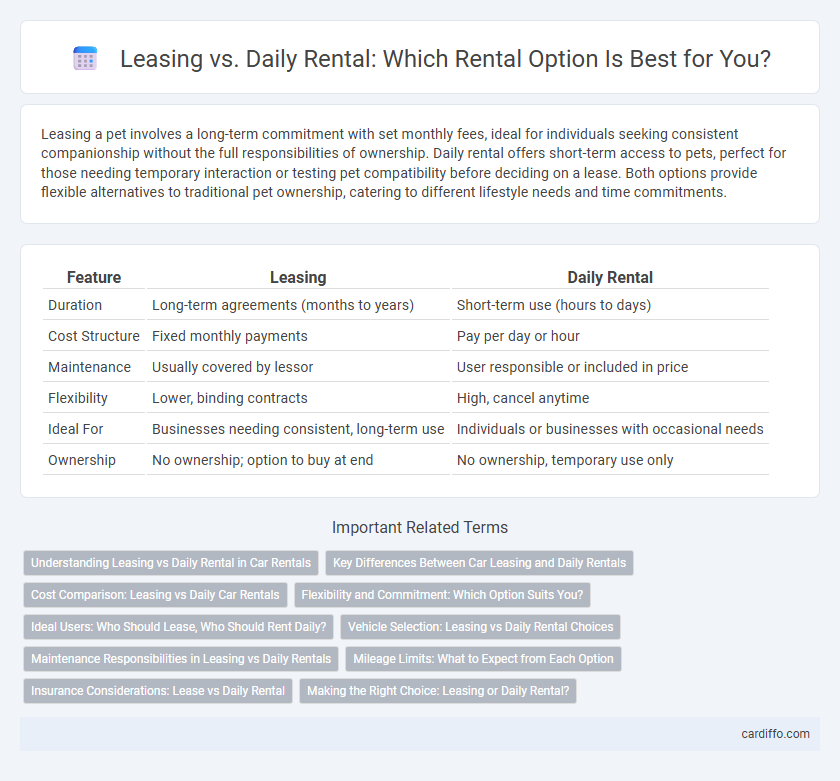Leasing a pet involves a long-term commitment with set monthly fees, ideal for individuals seeking consistent companionship without the full responsibilities of ownership. Daily rental offers short-term access to pets, perfect for those needing temporary interaction or testing pet compatibility before deciding on a lease. Both options provide flexible alternatives to traditional pet ownership, catering to different lifestyle needs and time commitments.
Table of Comparison
| Feature | Leasing | Daily Rental |
|---|---|---|
| Duration | Long-term agreements (months to years) | Short-term use (hours to days) |
| Cost Structure | Fixed monthly payments | Pay per day or hour |
| Maintenance | Usually covered by lessor | User responsible or included in price |
| Flexibility | Lower, binding contracts | High, cancel anytime |
| Ideal For | Businesses needing consistent, long-term use | Individuals or businesses with occasional needs |
| Ownership | No ownership; option to buy at end | No ownership, temporary use only |
Understanding Leasing vs Daily Rental in Car Rentals
Leasing a car involves a long-term contract, typically spanning 12 to 36 months, with fixed monthly payments and mileage limits, making it ideal for drivers seeking predictable costs and vehicle stability. Daily rental services offer short-term car access by the day, providing flexibility for travelers or those in need of temporary transportation without long-term commitments. Understanding the differences in cost structure, commitment duration, and usage purpose helps consumers choose between leasing for consistency or daily rental for convenience.
Key Differences Between Car Leasing and Daily Rentals
Car leasing involves long-term contracts typically lasting 12 to 36 months, offering lower monthly payments and options to buy the vehicle at the end of the lease term. Daily rental services provide short-term vehicle access, charged on a per-day basis, suitable for immediate, flexible, or occasional use without long-term commitment. Lease agreements often include mileage limits and maintenance clauses, whereas daily rentals charge based on rental duration and may have higher per-day costs but no binding contracts.
Cost Comparison: Leasing vs Daily Car Rentals
Leasing a vehicle typically involves lower monthly payments compared to the cumulative daily rental costs over an extended period, making it more cost-effective for long-term use. Daily car rentals often incur higher per-day rates, insurance fees, and limited mileage, which can quickly increase overall expenses. Businesses and individuals should analyze usage patterns to determine that leasing offers predictable budgeting and tax benefits, while daily rentals provide flexibility without long-term commitments.
Flexibility and Commitment: Which Option Suits You?
Leasing offers long-term vehicle use with fixed monthly payments and limited flexibility, ideal for users seeking stability and lower costs over time. Daily rental provides maximum flexibility without long-term commitment, allowing customers to rent vehicles on a day-to-day basis to suit fluctuating needs. Evaluating your usage frequency and financial priorities helps determine whether leasing's commitment or daily rental's adaptability better fits your lifestyle.
Ideal Users: Who Should Lease, Who Should Rent Daily?
Leasing is ideal for individuals or businesses requiring long-term vehicle use with stable monthly costs and minimal maintenance responsibilities, such as corporate employees or entrepreneurs. Daily rental suits travelers, temporary employees, or those needing flexible, short-term transportation without long-term commitments or paperwork. Understanding usage duration and budget constraints helps determine whether leasing or daily rental aligns best with user needs.
Vehicle Selection: Leasing vs Daily Rental Choices
Leasing vehicles offers access to a wide range of models with the ability to select specific brands, features, and configurations tailored to long-term needs, often including newer, well-maintained cars. Daily rental options prioritize flexibility, providing immediate availability and a variety of vehicle types for short-term use without long-term commitment. Choosing between leasing and daily rental depends on factors such as duration, budget constraints, and preference for either consistent vehicle selection or short-term convenience.
Maintenance Responsibilities in Leasing vs Daily Rentals
Leasing agreements typically assign long-term maintenance responsibilities to the lessee, requiring regular servicing and repairs to preserve the asset's condition. Daily rental providers handle most maintenance tasks, ensuring vehicles or equipment remain in optimal condition between short-term rentals. Understanding these distinctions helps businesses choose the best option for their operational needs and budget management.
Mileage Limits: What to Expect from Each Option
Leasing agreements typically include mileage limits ranging from 10,000 to 15,000 miles per year, with fees applied for exceeding these allowances. Daily rentals usually offer unlimited mileage, making them ideal for short-term use or long-distance travel without worrying about extra charges. Understanding mileage restrictions helps renters choose between cost-effective leasing contracts and flexible daily rental options.
Insurance Considerations: Lease vs Daily Rental
Leasing typically offers comprehensive insurance coverage as part of the contract, reducing the lessee's liability for damages and theft, while daily rentals require customers to either accept optional rental insurance or provide their own coverage. Lease agreements often include gap insurance and maintenance protection, ensuring financial security over long-term use, whereas daily renters must carefully assess collision damage waivers and liability limits to avoid unexpected expenses. Evaluating insurance policies is crucial in comparing leasing versus daily rental options to ensure adequate protection and cost-effectiveness.
Making the Right Choice: Leasing or Daily Rental?
Choosing between leasing and daily rental hinges on usage duration and cost efficiency, where leasing offers lower monthly rates suitable for long-term needs, while daily rental provides flexibility for short-term or occasional use. Leasing contracts typically span months to years with fixed payments, ideal for predictable budgets, whereas daily rentals charge by the day, catering to variable or temporary requirements. Assessing factors like frequency of use, budget constraints, and commitment level ensures the right rental option aligns with specific personal or business goals.
Leasing vs Daily Rental Infographic

 cardiffo.com
cardiffo.com